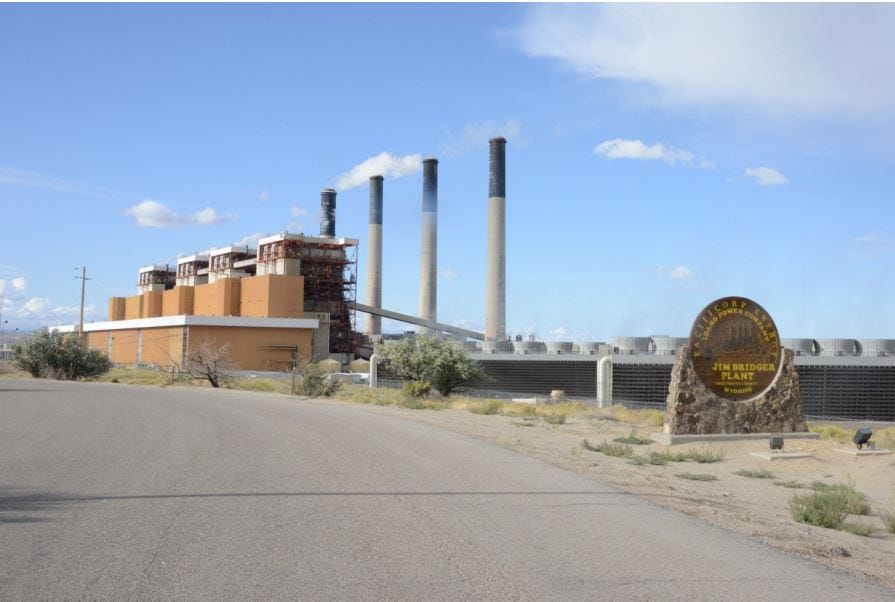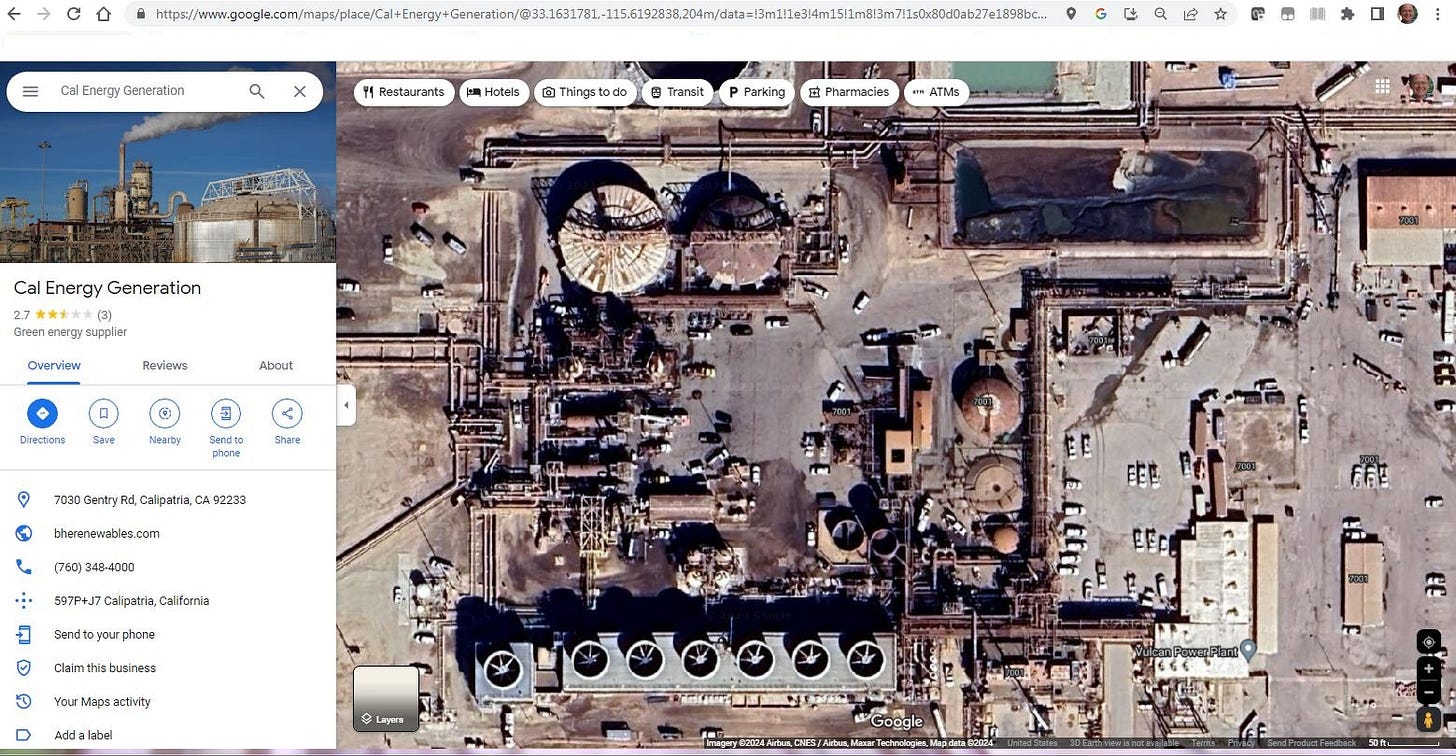BHE is a Likely Opponent of DCPP Extended Operations - Part 2
BHE's 2020 coal-fired generation was about 174% of DCPP's typical annual power production. BHE's 2020 natural gas-fired generation adds 67% of DCPP's production for a total of 241%.
Since Berkshire Hathaway Energy (BHE) subsidiary PacifiCorp has about 6,000 MW of coal-fired generation, and about 3,000 MW of natural gas-fired generation they likely have the capability to replace DCPP by increasing the utilization of their fossil-fired fleet. (BHE has attempted to develop California geothermal generation near the Salton Sea.)
Jim Bridger Power Plant, one of PacifiCorp’s nine coal fired power plants has a capacity of 2,441 MW, a larger capacity than DCPP at 2,256 MW. (Photo and generation capacity source: The Center for Land Use Interpretation.) In Part 1, some of the coal-friendly aspects of California energy policy were discussed.
BHE is a Likely Opponent of DCPP Extended Operations - Part 1
GreenNUKE is a reader-supported publication. To receive new posts and support my work, consider becoming a free or paid subscriber. This is the first installment of a series of GreenNUKE articles regarding the widespread use of coal-fired power imports in the allegedly climate-aware state of California. LADWP is planning on re-powering their large Interm…
1. PacifiCorp is a coal-centric electricity generator
PacifiCorp partially-owns or fully-owns nine coal-fired power plants operating in 2023: Colstrip, Craig, Dave Johnson, Hayden, Hunter, Huntington, Jim Bridger, Naughton, and Wyodak.
Here’s part of a spreadsheet regarding PacifiCorp’s coal-fired power plants operating in 2019. This spreadsheet appeared in several of CGNP’s CPUC filings critical of PacifiCorp’s operation of coal-fired power plants serving California’s electricity needs.
The total generating capacity of these 11 coal-fired power plants was 11,555 MW in 2019. North Valmy and Cholla Generating stations no longer operate. The pair of coal retirements total 1,549 MW.
The Clean Air Task Force (CATF) is a prominent environmental group that has been critical of PacifiCorp’s coal-fired generating fleet. (Coal - fired power plants cause toxic air pollution and toxic water pollution in contrast with the absence of air and water pollution from nuclear power plants such as DCPP.)
CATF’s methodology shows in 2019 the 11 PacifiCorp coal-fired power plants caused an estimated 276 deaths per year from their air pollution. Coal ash contains many toxic substances including water-soluble arsenic salts that may enter drinking water supplies. Some of PacifiCorp’s ash disposal facilities are ranked as highly polluting relative to the U.S. coal-fired generation fleet. (In contrast, more than six decades of operation of the entire U.S. nuclear power fleet of about 100 reactors has caused no radiation-induced deaths.)
2. PacifiCorp's recent public relations and lavishly-funded lobbying strategies
One approach employed by firms such as PacifiCorp which own such harmful facilities is to make documentation regarding their harms difficult or impossible to locate. CGNP archived PacifiCorp’s 2020 sustainability metrics which were previously available at https://brkenergy.com/assets/pdf/sustainability-pacificorp-2020.pdf Attractive outdoor scenes have replaced their informative tabulations at their website. (Archive.org’s “Wayback Machine” archived a copy of the PacifiCorp tabulation.)
CGNP studied the recent PacifiCorp mandatory quarterly Form 635 lobbying disclosures. The narrative in the forms essentially omits any reference to PacifiCorp’s wholesale coal-fired generation business. Similarly, there is no mention of BHE’s likely advocacy for CAISO grid regionalization which will be covered in an upcoming installment of this series.
Another PacifiCorp approach is to expend large sums lobbying California legislators and regulators. Data maintained by the California Secretary of State shows that PacifiCorp’s 2023 total lobbying expenditures were the fifth largest in the state at more than $5 million. The February 12, 2024 Cal Matters article “A record amount went to lobbying California’s government. Who were the biggest spenders?” by Jeremia Kimelman contains this ranking. HTTPS://CALMATTERS.ORG/POLITICS/2024/02/CALIFORNIA-LOBBYING-STATE-GOVERNMENT/
Review of the Cal-Access lobbying database shows that PacifiCorp outspent the much larger Pacific Gas and Electric Company (PG&E) by over a quarter-million dollars when directly lobbying the California Public Utilities Commission (CPUC) between 2019 and 2023. PacifiCorp spent $2,541,794.12 in this five-year-long direct lobbying campaign. Small nonprofits such as CGNP cannot afford to spend such gargantuan sums lobbying California’s important utility regulator. (The next installment will discuss the adverse consequences to CGNP from not being able to spend millions lobbying the CPUC.)
Per a tabulation at https://www.westerneim.com/Pages/About/QuarterlyBenefits.aspx at the Western Energy Imbalance Market (WEIM) website, two BHE subsidiaries PacifiCorp and NV Energy have completed wholesale sales now valued at more than $1.2 billion in mostly coal-fired electricity since November 2014 - principally to California entities. These wholesale sales via a daily spot market created by PacifiCorp collaborating with CAISO are exempt from the SB 1386 (Perata, 2006) performance standards for California long-term electricity supply contracts. Growing and expanding such sales requires lobbying expertise.
3. The long-term collaboration between BHE Attorney Jonathan Weisgall and V. John White
Finally, when spending millions of dollars each year lobbying California government entities, firms such as PacifiCorp need to hire experienced lobbyists for maximum effectiveness. According to the LinkedIn listing for Attorney Jonathan Weisgall, BHE’s Vice President, Government Relations has held that position for 31 years. Attorney Weisgall is listed as a lobbyist for BHE and some subsidiaries in the 2023-2024 Lobbying Directory maintained by the California Secretary of State.
The second BHE lobbyist is V. John White. He is listed as the Executive Director of the (misleadingly named) Center for Energy Efficiency and Renewable Technology (CEERT) and the owner of lobbying firm V. John White Associates. According to his LinkedIn listing, John has held each of those positions for 34 years. The 2023-2034 Lobbying Directory shows John’s clients include BHE and some subsidiaries. In addition, John is a representative for the similarly misleadingly-named “Clean Power Campaign“ (CPC.) Two other firms (including California Advocacy, LLC) also represent the CPC. (In addition, PacifiCorp is represented by California Advisors, LLC. ) Thus, BHE and its subsidiaries have retained very experienced lobbyists. As noted previously, this lobbying activity is lavishly funded.
Previous online editions of the Lobbying Directory maintained by the California Secretary of State show the collaboration between Attorney Weisgall and V. John White encompasses all of the available online Lobbying Directories from 2009-2010 onwards. V John White has been one of the representatives of the Clean Power Campaign since at least 2009-2010. The listing for CE Obsidian Energy LLC, a subsidiary of Mid American Energy Holdings, showed Attorney Weisgall's Washington, DC address in the 2009-2010 Lobbying Directory - and that V. John White's firm represented the firm in Sacramento.
Apparently, a geothermal power plant was constructed near the southern end of the Salton Sea in Calipatria, CA. Taxpayer-funded subsidies played a role in constructing the plant. According to https://www.gem.wiki/Imperial_Valley_geothermal_plant this geothermal plant has been shelved. The current Cal Energy Generation overhead photograph from Google shows the heat exchanger fans are stationary. There are no shadows showing steam being emitted from the plant equipment.
CGNP considers that BHE and its subsidiaries have also utilized third party proxies as a useful adjunct to the above approaches. One of those proxies is CEERT, identified in the previous paragraph. V. John White, in 2016 in conjunction with CEERT helped to create for DCPP ideological opponent Friends of the Earth (FoE) a DCPP cost projection https://foe.org/wp-content/uploads/2017/legacy/PlanBfinal.pdf .
This CEERT - FoE report projected by 2024 that DCPP power would become extremely overpriced. (Such a cost projection runs contrary to nuclear industry experience.) On August 30, 2022, the Breakthrough Institute soundly debunked the DCPP cost projections in the 2016 CEERT - FoE report. "The Faulty Diablo Canyon Study that Started it All - How Friends of the Earth and a Prominent Renewable Energy Lobbyist Hoodwinked California Policy-Makers," by Jonah Messinger, Seaver Wang, and Adam Stein. https://thebreakthrough.org/issues/energy/the-faulty-diablo-canyon-study-that-started-it-all.
CGNP believes a relevant fact is that Attorney Weisgall served as the Chair of the CEERT Board approximately during the time the 2016 CEERT report regarding DCPP was produced and publicized. Attorney Weisgall returned as Chair of the CEERT Board during the roughly 2022-2023 timeframe when DCPP extended operations were being debated by the California legislature and the CPUC. Could Attorney Weisgall’s CEERT Board leadership be considered to be a conflict of interest? Currently, Attorney Weisgall serves as the Chair of the Board of the CPC (identified in the previous paragraph. The CPC Facebook page shows opposition to DCPP extended operations. Thus, the pair of BHE lobbyists Attorney Jonathan Weisgall and V. John White have been collaborating for an extended period on projects that oppose DCPP extended operations. If DCPP were to be needlessly shut down, the increased BHE profitability would likely be denominated in the billions of dollars each year. Please comment below. Do you think there is a connection between the ongoing threat to DCPP extended operations and the long-term collaboration of these two BHE lobbyists?









If you want the truth following the money generally gets you there.